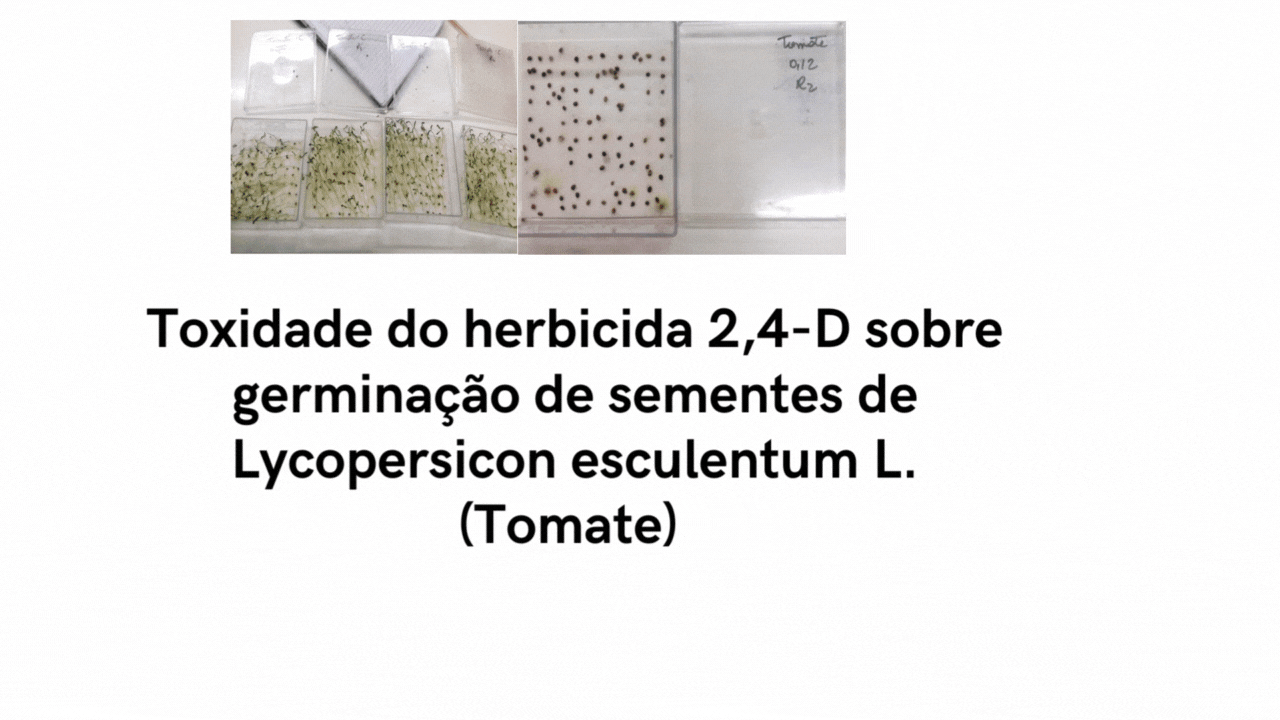Toxicity of 2,4-D herbicide on seed germination of Lycopersicon esculentum L.
DOI:
https://doi.org/10.20873/jbb.uft.cemaf.v10n4.francaKeywords:
tomatoes, pesticides, seedling phytotoxicityAbstract
Dichlorophenoxyacetic acid (2.4 - D (C8H6Cl2O3) is a herbicide widely used in the national territory. The World Health Organization (WHO) classifies 2.4-D as low toxic, harmful if ingested or inhaled. Studying the effects of its use in seeds of fruits that are on the table of the Brazilian, contributes in the scope of research and especially agriculture. Tomato seeds (Lycopersicon esculentum) originates from South America, and is grown almost all over the world, has high commercial value and the fruit has gastronomic importance and health benefits generating high consumption. The present work analyzed the effect of herbicide 2,4-D toxicity on the germination of L. esculentum seeds in 7 and 14 days. The experiment followed a completely randomized design, using one control and three concentrations of the herbicide 2.4-D (0.04, 0.08 and 0.12 mg/mL) with four replications. It was used as substrate germitest paper, allocated in gerbox and deposited in germination chamber at the temperature of 25 and 14 days. Data normality (Shapiro-Wilki) was used to choose the appropriate statistical test and better data presentation. The data did not show normality with a p-value lower than 0.05, the Kruskal-Wallis and Dunn posteriori tests were performed. Tomato seeds were completely intolerant to the herbicide. Even at low concentrations, there was no germination, only of the witness. The 2.4 D was fatal for the germination of tomato seeds.
References
Agarwa R, Av R. Tomato lycopene and its role in human health and chronic diseases. Canadian Medical Association Journal, v.163, n.6, p.739-744, 2000.
ANVISA (2022). Monografia 2,4-D. Disponível em: <https://www.gov.br/anvisa/pt-br/setorregulado/regularizacao/agrotoxicos/monografias/monografias-autorizadas/d/4285json-file-1/view>. Acesso em: 28 set. 2022.
Bhatia P, Ashwath N, Senaratna T, Midmore D. Tissue culture studies of tomato (Lycopersicon esculentum). Plant Cell, Tissue andOrgan Culture, Dordrecht, v.78, p.1-21, 2004.
Christoffoleti PJ, Figueiredo MRA, Peres LEP, Nissen S, Gaines T. Auxinic herbicides, mechanisms of action, and weed resistance: A look into recent plant science advances. Scientia Agricola, v.72, n.4, p.356-362, 2015. https://doi.org/10.1590/0103-9016-2014-0360
Cobb AH, Reade JPH. Herbicides and plant physiology. John Wiley & Sons, 298p. 2010.
Fontana N. Efeitos da deriva simulada de 2,4-D sobre feijão, soja, tomateiro e videira. 2021. 62 f. Trabalho de Conclusão de Curso (Bacharelado em Agronomia) - Universidade Tecnológica Federal do Paraná, Pato Branco.
Friedrich K. Avaliação dos efeitos tóxicos sobre o sistema reprodutivo, hormonal e câncer para seres humanos após o uso do herbicida 2,4-D. Rio de Janeiro: Instituto Nacional de Controle de Qualidade em Saúde da Fundação Oswaldo Cruz. 44p. 2014. (Fiocruz)
Grossmann K. Auxin herbicides: current status of mechanism and mode of action. Pest Management Science, v.66, n.2, p.113-120, 2010. https://doi.org/10.1002/ps.1860
Guedes RS, Alves EU, Golçalves EP, Braga Júnior JM, Viana JS, Colares PNQ. Substratos e temperaturas para testes de germinação e vigor de sementes de amburana cearenses (Al-lemão) A.C. Smith. Revista Árvore, v.34, n.1, p.57-64, 2010. https://doi.org/10.1590/S0100-67622010000100007
Islam F, Farooq MA, Gill RA, Wang J, Yang C, Ali B, Wang G-X, Zhou W. 2,4-D attenuates salinity-induced toxicity by mediating anatomical changes, antioxidant capacity and cati-on transporters in the roots of rice cultivars. Scientific Re-ports, v.7, n.1, p.1-23, 2017. https://doi.org/10.1038/s41598-017-09708-x
Kelley KB, Riechers DE. Recent developments in auxin biolo-gy and new opportunities for auxinic herbicide research. Pesticide Biochemistry and Physiology, v.89, n.1, p.1-11, 2007. https://doi.org/10.1016/j.pestbp.2007.04.002
Lara-Núñez A, Sobeida Sánchez-Nieto S, Anaya AL, Cruz-Ortega R. Phytotoxic effects of Sicyos deppei (Cucurbita-ceae) in germinating tomato seeds. Physiologia Plantarum, v.136, n.2, p.180-192, 2009. https://doi.org/10.1111/j.1399-3054.2009.01228.x
Macedo Neto D, Froehne S, Machado KS. Avaliação do transporte do ácido 2,4-diclorofenoxiacético através de um lisímetro. Química Nova, v.35, n.9, p.1809-1813, 2012. https://doi.org/10.1590/S0100-40422012000900020
Miranda FFR. Efeito da frutificação induzida por 2,4-D em características agronômicas dos frutos de abóbora ‘Tetsu-kabuto’. 2012. 62 p. Dissertação (Mestrado em produção vegetal) - Universidade Federal do Tocantins, Gurupi.
Song Y. Insight into the mode of action of 2,4-dichlorophenoxyacetic acid (2,4-D) as an herbicide. Journal of integrative plant biology, v.56, n.2, p.106-113, 2014. https://doi.org/10.1111/jipb.12131
Vieira EM, Prado AGS, Landgraf MD, Rezende MOO. Estu-do da adsorção/dessorção do ácido 2,4 diclorofenoxiacético (2,4d) em solo na ausência e presença de matéria orgânica. Química Nova, v.22, n.3, p.305-308, 1999. https://doi.org/10.1590/S0100-40421999000300002
Yamashita OM, Borges RH, Carvalho MAC. Efeito de três herbicidas na germinação de corda-deviola (Ipomoea quamoclit) em substrato umedecido. Revista Científica Eletrônica de Agronomia, v.17, n.1, p.17-22, 2010.

Downloads
Published
How to Cite
Issue
Section
License
Copyright (c) 2022 Roberta Sorhaia Samayara Sousa Rocha de França, Jean Carlo Possenti , Asser Botelho Santana

This work is licensed under a Creative Commons Attribution 4.0 International License.
Copyright (c) 2024 - Journal of Biotechnology and Biodiversity

This work is licensed under a Creative Commons Attribution 4.0 International License.
Authors who publish with this journal agree to the following terms:
Authors retain copyright and grant the journal right of first publication with the work simultaneously licensed under a Creative Commons Attribution License (CC BY 4.0 at http://creativecommons.org/licenses/by/4.0/) that allows others to share the work with an acknowledgement of the work's authorship and initial publication in this journal.
Authors are able to enter into separate, additional contractual arrangements for the non-exclusive distribution of the journal's published version of the work (e.g., post it to an institutional repository or publish it in a book), with an acknowledgement of its initial publication in this journal.
Authors are permitted and encouraged to post their work online (e.g. in institutional repositories or on their website) prior to and during the submission process, as it can lead to productive exchanges, as well as earlier and greater citation of published work (Available at The Effect of Open Access, at http://opcit.eprints.org/oacitation-biblio.html).


